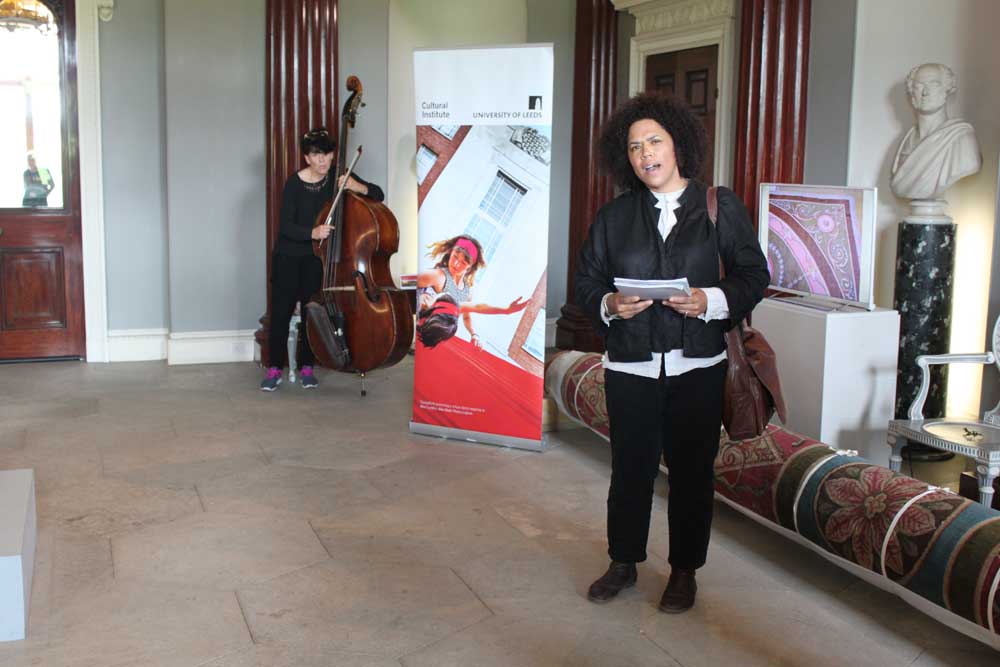A poem for Harewood’s Axminster carpets
The acclaimed poet Rommi Smith has written a new poem in response to Harewood House Trust’s on-going reassessment of its historic Axminster carpets and as part of a partnership with Leeds University’s Yorkshire Year of the Textile programme.
These unique carpets have survived since the late 18th century and were specifically commissioned for the Music Room and Yellow Drawing Room – both designed by the architect Robert Adam. They are very rare examples of carpets still shown in the original rooms that they were designed to compliment.
Rommi Smith wrote the poem Notes for an Axminster Carpet and performed it here on the 20th May 2017 accompanied by the composer and musician Jenni Molloy.
The poem is composed of a short series of imagined notes as if written by Robert Adam, to Thomas Whitty, proprietor of the Axminster Factory, Devon, where the carpets originated from.
The poems make reference to classical motifs that can be seen in the rooms for which the carpets were specially created and to historical notes written about the carpets and their rooms.
These poem-notes, could be considered directorial, almost theatrical, notes from Adam to Whitty. The poem, in homage to the carpets, is also site-specific, therefore, each section of the poem should, ideally, be read in the location for which it was written and intended to be performed.
Notes for an Axminster Carpet
By Rommi Smith
‘I was surprised to find such a little paltry place the origin of so much magnificence. The manufactory is all the property of one man. The work is chiefly done by women […] They were then employed in weaving a large carpet for Lord Harewood, late Mr Lascelles, which was to cost one hundred and forty pounds.’ – Reverend ED Clarke on his visit to the Axminster factory, 1791.
‘I […] had engaged myself for tomorrow […]’ Robert Adam, London: June, 7, 1788.
Note 1: Hallway
Mr. Thomas Whitty, Proprietor
Axminster Factory
Silver Street
Devon
England
Dear Sir,
please accept –
these notes for an Axminster carpet.
I send them, accompanied by these drawings,
not so much directions, but as artefacts of longing:
what we make of the moment
we leave for the pleasure of tomorrow.
Envisage (if you will), a hall
beyond the grounds that time will anoint
with Capability’s hands,
where a man might stand
as though he were the first at all;
my namesake; a song of alabaster:
earth-footed, yet jubilant face in heavenward devotion
to the firmament scored with stars on staves of Hallelujah.
This, then, Sir is the music, this is the pitch
from which this first note for the design emerges.
Note II: The Terrace
Vista our trade, desire our bread –
these are the dreams from which to craft the threads:
the earth the warp, the sky the weft
with which to divine Nature’s Carpet.
Note III: Yellow Drawing Room
To the tune of yellow silk (colour of July, or a midday
Badian sun) this carpet must succumb.
It will have a central, circular medallion
containing a bloom-head encased in anthemion
set into the heart of a four-pointed star.
Behind it, unfurling acanthus,
within dusk-rose and olive chain –
rosette borders, panels at each end.
This, Sir, will be the design, complimented
by the clean, yet ostentatious lines
of Mr. Chippendale’s imagination.
Note IV: The Music Room
At its heart, a central motif extending out
into a parasol of dawn-pink and spring leaves,
til the ‘unheard melodies’ of lyres,
which take their pitch from an Italian-green universe,
where large planets of rosette are circled by constellations
of light. The edges of this galaxy form an outer pole and ribbon stripe.
Carpet should be to ceiling – as earth is to sky.
With this carpet, one should expect
to better understand why we bury a man
in order for his soul to rise
and occupy the glory of a place in heaven –
https://blackmenheal.org/wp-content/languages/new/zithromax.html
yours sincerely,
Mr. Robert Adam.




